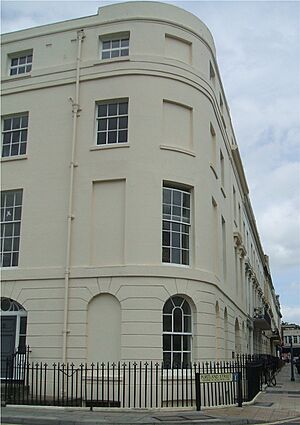Window tax facts for kids
The Window tax was a special kind of property tax that people had to pay based on how many windows their house had. This tax was a big deal in England, France, and Ireland during the 1700s and 1800s. It even changed how houses looked! To avoid paying too much tax, some people bricked up their windows. This means they filled the window spaces with bricks.
In England and Wales, the window tax started in 1696 and ended 155 years later, in 1851. France had this tax from 1798 to 1926. Scotland also had a window tax from 1748 until 1851.
Contents
What Was the Window Tax?
The window tax was first brought in for England and Wales in 1696 by King William III. The idea was to tax people based on how wealthy they seemed to be. This was a way to collect money without starting an income tax, which many people didn't like back then.
Why People Didn't Like Income Tax
At that time, many people in Britain were against income tax. They felt that telling the government how much money you earned was too personal. They saw it as the government getting too involved in their private lives. The first real income tax in Britain didn't even start until 1842, and it was still a debated topic for a long time.

How the Tax Was Calculated
When the window tax began, it had two parts:
- A basic house tax of two shillings for every house.
- An extra tax based on the number of windows. If a house had between ten and twenty windows, it paid an extra four shillings. If it had more than twenty windows, it paid an extra eight shillings.
Over the years, the rules for the tax changed a few times.
- In 1709, when England and Scotland joined, the taxes became similar. A new higher tax was added for houses with 30 or more windows.
- In 1747, the basic house tax was separated from the window tax. The way the window tax was figured out also changed. For example, houses with 10-14 windows paid 6 pence for each window.
- In 1766, the number of windows that caused a tax to be charged was changed to seven. Later, in 1825, it changed to eight.
Who Paid the Tax?
In 1778, the basic house tax changed again. Instead of a flat rate, it depended on how much the property was worth. People who were very poor and didn't have to pay other local taxes were also free from paying the window tax.
The window tax was fairly easy for the government to check. They could just count the windows from outside the house! Generally, bigger houses had more windows, so their owners paid more tax. However, many people didn't like this tax. They felt it was a tax on "light and air," which seemed unfair.
What People Thought About the Tax
A famous thinker named Adam Smith talked about the window tax in his book, The Wealth of Nations. He noted that it was easy to check because tax collectors didn't need to go inside homes. But he also said that others thought the tax was unfair because it seemed to affect poorer people more.
In Scotland, the window tax started after 1748. A house needed to have at least seven windows or a rent of £5 to be taxed. Sometimes, windows were filled in with bricks not because of the tax, but for other reasons. For example, to make a building look even, or because there was a staircase or fireplace behind that spot. France also had a similar tax from 1798 to 1926.
When the Tax Ended
There was a strong movement in England to get rid of the window tax in 1850 and 1851. Because of this, the tax was finally removed on July 24, 1851. A new tax on inhabited houses took its place. The Scottish window tax was also ended at the same time.
Common Myths
You might have heard the saying "daylight robbery." Some people think it came from the window tax, but there's no real proof of this. Another common story is that the tax made Europeans start bricking up windows. While windows were bricked up to avoid taxes from the 1600s, blind windows (windows that were never meant to be open) were used for looks even before the tax, like on the Church of Saint John the Baptist, Kerch, built in 757 AD.
See also
- Bedroom tax
- Brick tax
- Glass tax
- Hearth tax
- Wallpaper tax

